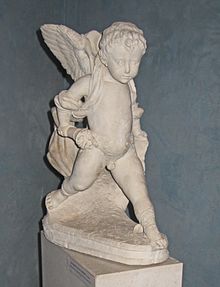Giovanni Dalmata
Giovanni Dalmata , actually Ivan Duknović de Tragurio , also Giovanni di Traù , or Johannes Duknovich (* around 1440 in Vinišće ; † after 1514 in Trogir ), was a Croatian-Italian sculptor from Dalmatia, who spent most of his artistic life in Rome, Hungary and Dalmatia spent. He worked with Andrea Bregno and Mino da Fiesole on large tomb and altar projects in Rome in the second half of the 15th century and is one of the most important sculptors of his time.
life and work
Giovanni Dalmata was born around 1440 in Vinišće , a small fishing village near Trogir , in Dalmatia . Dalmatia has belonged to the Republic of Venice since 1409 . Between 1460 and 1465 Dalmata was called to Rome by the Venetian Pope Paul II, along with other Lombard stonemasons . He first worked in the Palazzo Venezia .
During his stay in Rome he created, among other things:
- Statues of the apostles in the Vatican grottoes ,
- the crucifixion in the church of Santa Balbina with Mino da Fiesole ,
- Relief: Christ carried by two angels (fig.) In the church of Sant'Agostino (Rome); vestibule
- 1466 the grave monument for Cardinal Giacomo Tebaldi with Andrea Bregno in the church of Santa Maria sopra Minerva ,
- 1467 the main portal of the Palazzo Venezia ,
- 1474 the grave monument for Cardinal Pietro Riario together with Andrea Bregno and Mino da Fiesole in the church of Santi XII Apostoli ,
- 1474 the tabernacle in the sacristy of San Marco (Rome)
- 1476 the grave monument for Cardinal Bartolomeo Roverella in the Basilica of San Clemente
- 1478 the tomb of Cardinal Fericci in the cloister of the church Santa Maria sopra Minerva ,
- after 1479 a blessing Christ and the tomb of Cardinal Berardo Eroliin the Vatican grottoes.
- the Tempietto S. Giacomo in Vicovaro (near Tivoli ),
This was followed by the grave monument attributed to him for Maddalena Orsini in the refectory of the monastery of San Salvatore in Lauro and the Transenna with pilasters and candelabra in the Sistine Chapel , together with Andrea Bregno and Mino da Fiesole .
Among the works carried out in Rome, one work stands out in particular: the impressive grave monument for Pope Paul II with many statues and reliefs, which was once in the Constantinian St. Peter's Basilica. It has now been restored and is located in an octagon above the transept of St. Peter's Church. On the completion of this monument he worked with Mino da Fiesole , from which the reliefs of the reclining Pope, Hope, the glorious God the Father, the angels with the inscription, the creation of Eve, the original sin, the resurrection of Christ and the apostles Mark and Matthew originate. Around 1469, he created the sculptures Madonna with Child, Apostle and Angel for the Church of San Giovanni in Norcia , which are now in the Museo diocesano La Castellina.
In the years 1481 and 1485 to approx. 1490 Giovanni Dalmata can be found at the court of King Matthias Corvinus in Hungary , where he was appointed court sculptor. However, the numerous works he created are no longer preserved.
After his stay in Hungary, Giovanni Dalmata returned to Trogir. He left many works there, including the statue of John the Evangelist in the Orsini Chapel of Trogir Cathedral . He also designed the statue of St. Mary Magdalene in the Franciscan convent of Sant'Antonio near the island of Čiovo and worked with Niccolò di Giovanni Fiorentino and Andrea Alessi at the Renaissance palace Cippico in Trogir.
Around 1503 he returned to Rome and worked on the grave monument of the apostolic pronotary Lomellino. In 1509 he is in Ancona , where he created the grave monument of the Blessed Girolamo Giannelli in the Cathedral of Ancona. Some documents from 1513 and 1514 mention a Magistro Joanni lapicida who was probably identical with Dalmata in Trogir, where he probably died.
There are six of his works in the Trogir City Museum.
literature
in alphabetical order by authors / editors
- Marco Bussagli (ed.): Rome - Art and Architecture , Krönemann Verlag Cologne, 1999, ISBN 3-8290-2258-1
- Duško Kečkemet: Duknović, Giovanni. In: Fiorella Bartoccini (ed.): Dizionario Biografico degli Italiani (DBI). Volume 42: Dugoni – Enza. Istituto della Enciclopedia Italiana, Rome 1993.
- Kruno Prijatelj: Giovanni Dalmata In: The dictionary of art.
- Johannes Röll: Giovanni Dalmata (= Roman Studies of the Biblioteca Hertziana 10). Wernersche Verlagsgesellschaft, Worms 1994, ISBN 3-88462-108-4
Web links
Individual evidence
- ↑ [1] Unesco document with a short biography, point 31
- ↑ not publicly accessible
- ↑ Rome, Art and Architecture, p. 369
- ^ Homepage in Oxford Art Online
| personal data | |
|---|---|
| SURNAME | Dalmata, Giovanni |
| ALTERNATIVE NAMES | Duknovich, Ivan; Duknović, Ivan; Giovanni da Traù |
| BRIEF DESCRIPTION | Dalmatian sculptor |
| DATE OF BIRTH | around 1440 |
| PLACE OF BIRTH | Vinišće |
| DATE OF DEATH | after 1514 |
| Place of death | Trogir |



